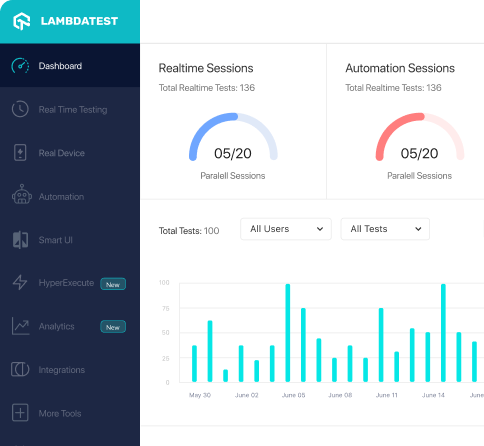How to use AbstractAssert_isNotOfAnyClassIn_Test class of org.assertj.core.api.abstract package
Best Assertj code snippet using org.assertj.core.api.abstract.AbstractAssert_isNotOfAnyClassIn_Test
...20 * Tests for <code>{@link ObjectAssert#isNotOfAnyClassIn(Class...)}</code>.21 * 22 * @author Nicolas François23 */24public class AbstractAssert_isNotOfAnyClassIn_Test extends AbstractAssertBaseTest {25 @Override26 protected ConcreteAssert invoke_api_method() {27 return assertions.isNotOfAnyClassIn(Long.class, File.class);28 }29 @Override30 protected void verify_internal_effects() {31 verify(objects).assertIsNotOfAnyClassIn(getInfo(assertions), getActual(assertions), new Class[] { Long.class, File.class });32 }33}...AbstractAssert_isNotOfAnyClassIn_Test
Using AI Code Generation
1package org.assertj.core.api.abstract_; 2import static org.assertj.core.api.Assertions.assertThat; 3import org.junit.Test; 4public class AbstractAssert_isNotOfAnyClassIn_Test { 5 public void test_isNotOfAnyClassIn() { 6 final AbstractAssert_isNotOfAnyClassIn_Test self = this; 7 assertThat(self).isNotOfAnyClassIn(AbstractAssert_isNotOfAnyClassIn_Test.class, 8 AbstractAssert_isNotOfAnyClassIn_Test.class); 9 } 10}11package org.assertj.core.api.abstract_; 12import static org.assertj.core.api.Assertions.assertThat; 13import org.junit.Test; 14public class AbstractAssert_isNotOfAnyClassIn_Test { 15 public void test_isNotOfAnyClassIn() { 16 final AbstractAssert_isNotOfAnyClassIn_Test self = this; 17 assertThat(self).isNotOfAnyClassIn(AbstractAssert_isNotOfAnyClassIn_Test.class, 18 AbstractAssert_isNotOfAnyClassIn_Test.class); 19 } 20}21package org.assertj.core.api.abstract_; 22import static org.assertj.core.api.Assertions.assertThat; 23import org.junit.Test; 24public class AbstractAssert_isNotOfAnyClassIn_Test { 25 public void test_isNotOfAnyClassIn() { 26 final AbstractAssert_isNotOfAnyClassIn_Test self = this; 27 assertThat(self).isNotOfAnyClassIn(AbstractAssert_isNotOfAnyClassIn_Test.class, 28 AbstractAssert_isNotOfAnyClassIn_Test.class); 29 } 30}31package org.assertj.core.api.abstract_; 32import static org.assertj.core.api.Assertions.assertThat; 33import org.junit.TestBlogs
Check out the latest blogs from LambdaTest on this topic:
The web paradigm has changed considerably over the last few years. Web 2.0, a term coined way back in 1999, was one of the pivotal moments in the history of the Internet. UGC (User Generated Content), ease of use, and interoperability for the end-users were the key pillars of Web 2.0. Consumers who were only consuming content up till now started creating different forms of content (e.g., text, audio, video, etc.).
The key to successful test automation is to focus on tasks that maximize the return on investment (ROI), ensuring that you are automating the right tests and automating them in the right way. This is where test automation strategies come into play.
“Test frequently and early.” If you’ve been following my testing agenda, you’re probably sick of hearing me repeat that. However, it is making sense that if your tests detect an issue soon after it occurs, it will be easier to resolve. This is one of the guiding concepts that makes continuous integration such an effective method. I’ve encountered several teams who have a lot of automated tests but don’t use them as part of a continuous integration approach. There are frequently various reasons why the team believes these tests cannot be used with continuous integration. Perhaps the tests take too long to run, or they are not dependable enough to provide correct results on their own, necessitating human interpretation.
Have you ever visited a website that only has plain text and images? Most probably, no. It’s because such websites do not exist now. But there was a time when websites only had plain text and images with almost no styling. For the longest time, websites did not focus on user experience. For instance, this is how eBay’s homepage looked in 1999.
Agile has unquestionable benefits. The mainstream method has assisted numerous businesses in increasing organizational flexibility as a result, developing better, more intuitive software. Distributed development is also an important strategy for software companies. It gives access to global talent, the use of offshore outsourcing to reduce operating costs, and round-the-clock development.
Automation Testing Tutorials
Learn to execute automation testing from scratch with LambdaTest Learning Hub. Right from setting up the prerequisites to run your first automation test, to following best practices and diving deeper into advanced test scenarios. LambdaTest Learning Hubs compile a list of step-by-step guides to help you be proficient with different test automation frameworks i.e. Selenium, Cypress, TestNG etc.
LambdaTest Learning Hubs:
- JUnit Tutorial
- TestNG Tutorial
- Webdriver Tutorial
- WebDriverIO Tutorial
- Protractor Tutorial
- Selenium 4 Tutorial
- Jenkins Tutorial
- NUnit Tutorial
- Jest Tutorial
- Playwright Tutorial
- Cypress Tutorial
- PyTest Tutorial
YouTube
You could also refer to video tutorials over LambdaTest YouTube channel to get step by step demonstration from industry experts.
Most used methods in AbstractAssert_isNotOfAnyClassIn_Test
Try LambdaTest Now !!
Get 100 minutes of automation test minutes FREE!!



